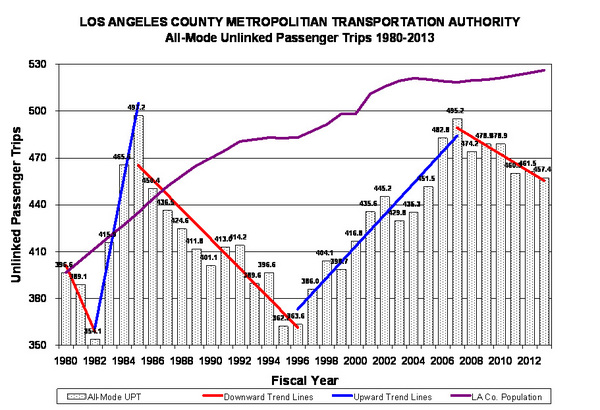In the run-up to this November’s big ballot initiative in Los Angeles County to raise revenue for transit through a higher sales tax, the pro-transit nonprofit Move LA argues that improved connectivity will boost ridership:
The new measure could deliver the necessary votes because it more than quadruples the connectivity of the rail system: Before Measure R riders could transfer from one line to another at 7 stations in the system, but the new measure would build projects that increase the number of transfer points to 32, enabling people to get from one corner of the county to any other corner. This is the secret sauce that will make ridership grow!
It’s a relatively minor quibble, but the real secret sauce to boosting ridership is to build more homes and offices within walking distance of the transit stations. Certainly more connectivity and faster service helps. But in the meantime, the region has plenty of transit stations that are operating now that could be leveraged to boost ridership.
And if the measure passes, it would be helpful if transit leaders could offer some guarantee that new spending on transit lines will be conditioned on this supportive land use development. Otherwise, the region will be replicating a pattern of under-performance that is still a major challenge for ridership in the existing system.
In response to the hullabaloo about long-term transit ridership in Los Angeles, transportation planner Jarrett Walker of Human Transport argues that the Los Angeles Times basic claim of ridership decline since 2006 is premature:
Sure, ridership is down 10% since 2006. But it’s up since 2011 and way up since 2004. Want to talk about the grand sweep of history? [Los Angeles Times reporter Laura] Nelson says that ridership is lower than it was 30 years ago, which sounds terrible, but it’s higher than it was 25 years ago! Thirty years ago, by the way, was fiscal year 1984-85, the year of the Olympics, so of course ridership was unusually high.
With a trendline like the one in the chart, you can say anything you want by comparing some past year to the present. Your conclusion is about the year you chose.
Walker makes the overall point that transit ridership in L.A. has been generally flat since 2006, “going up and down in about a 10% band, with no sign of strong movement in any direction.” He then tweeted in response to a Streetsblog LA article:
Again, we don't know yet that LA transit ridership is trending down. @StreetsblogLA @yfreemark @EthanElkind @latime https://t.co/fhIcqBMs6R
— Jarrett Walker (@humantransit) January 30, 2016
I share Walker’s concern about cherry-picking baseline years (although his point about the 1984 Olympics boosting ridership that fiscal year is actually not true — the few million extra riders for the Olympics was a drop in the overall bucket [PDF] — h/t Henry Fung).
But is it really too soon to start identifying recent trends in ridership patterns? Particularly when you look at the historical context for the trends over the long term, the recent dip may not be as indeterminate as Walker makes it sound.
Bus rider advocates have been making the point for years now that ridership trends are directly correlated to fare increases or decreases. And as someone who has studied the history of rail transit policies in Los Angeles for the book Railtown, I find their evidence compelling. For example, take Robert Garcia’s 2012 post on ridership trends, in which he uses data from longtime rail critic Tom Rubin to argue:
There are five clear periods of ridership change in the 34 years up to the current fiscal year. In the three periods when fares were increased, bus service was reduced, and the emphasis was on spending as much money as possible on rail, total riders dropped significantly. In the two periods when the fares were reduced or held constant and the quantity and quality of service improved, ridership increased hugely — even when MTA was spending half of its funding on rail to carry under 20% of the riders.
Here’s the chart to illustrate the point:
The 5 periods of transit ridership changes correspond to 1) rising fares until 1982 when 2) the three-year fare decrease from a 1980 ballot measure went into effect from 1982-1985, 3) fare increases following 1985 until 4) the famous Bus Riders Union-MTA consent decree in effect from 1996 to 2006 kept fares steady, and then 5) rising fares since 2007 leading to the present downward trend.
While the trend lines on the chart above may not be super precise, they do lend credence to the idea that fares are potentially the major factor determining ridership. And they are often a proxy for larger economic trends, as recessions squeeze transit budgets which too often leads transit agencies to raise fares. They also indicate that it may not be too soon to start identifying a recent trend, contra Walker, given the historical pattern.
If this is true, and we care about maximizing ridership, then Metro’s first response to the latest ridership decreases should be to re-examine the fare structure. And in the long-term, the agency should focus on improved bus service through bus-only lanes and encouraging local governments to build more affordable housing and offices near rail stops.



